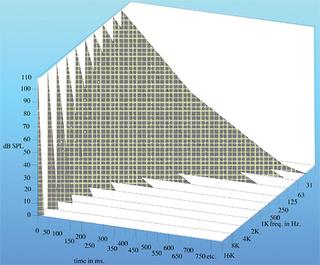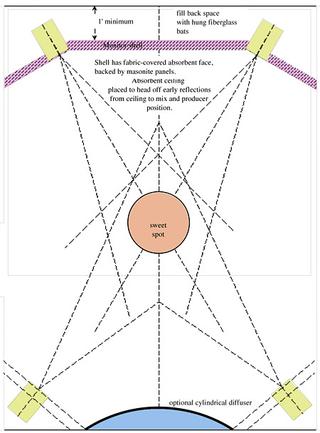Helping Control Rooms Handle Low Frequencies
Alert readers might recall I discussed issues pertaining to low-frequency standing waves in my last column. As a continuation of this consideration of low-frequency problems and issues, I want to devote this column to discussing how we can manage to treat our control rooms so they provide us with consistent low-frequency information that "travels well" to other listening rooms (those owned by our viewers, for instance). This is not easy to do, and impossible to do perfectly.
THE FREQUENY RESPONSE OF A ROOM
It would be nice to think of rooms as just having "frequency response" curves, like an equalizer. If it were true, we could simply adjust that response until it was flat, and everything would sound terrific.
Unfortunately, it doesn't work quite like that. However, rooms do have "acoustical signatures" that impart a distinct timbre (similar to frequency response) to the sound.
For reasons that are way beyond the scope of this column, such acoustical signatures are used by our hearing to (a) identify and localize any sound source in the room and (b) identify, describe and localize the boundaries of the room and their acoustical qualities.
Our hearing also "sets aside" much of that room's acoustical signature in a remarkable bit of precognitive processing, so that we manage to differentiate "the sound of the source" from "the sound of the room."
At a conscious level, we have little sense of this process, which is partly why "hearing rooms" are so difficult. Interestingly, microphones cannot do this and therefore do not "set aside" those acoustical signatures (an important topic whose discussion needs to wait for another day).
Much about the acoustical signature of a room is temporal, based on how rapidly the sound decays (dies away) as a function of various frequencies present in the sound.
This set of decays is in turn determined by (a) the size, dimensions and volume of the room and (b) the physical nature of the various wall, ceiling and floor surfaces of the room.

Fig. 1: Idealized decay times of a kick drum in a small to medium room Fig. 1 shows the idealized decay time of a kick drum in a room. Note that the times are different across the spectrum, and that will vary as a function of absorption at frequency.
ABSORBING LOW FREQUENCIES
It would be nice if we could use materials that would absorb equal amounts of energy from all frequencies (all wavelengths). Such materials do exist and are for sale for the creation of anechoic chambers—very large foam wedges, which absorb all sound energy at all frequencies.
Such treatments are very expensive and inappropriate, both architecturally and sonically, for rooms used for the production of audio for music, film and television. See my book, "Total Recording," for a detailed discussion of this.
In fact, we find it easy to make surfaces absorb high frequencies (and the result is quite audible to us), using fairly inexpensive and non-intrusive wall coverings. However, such treatments tend not to absorb low frequencies. The result is that we often end up with an "acoustically treated" room that is quite dead at high frequencies (very short decay times) and quite live and boomy at low frequencies (longer decay times). Not good.
To make the room at least partially absorptive at low frequencies, we need treatments that are quite large (we are dealing with long wavelengths, remember), possibly quite thick (could be several feet), and generally quite expensive (they use a lot of material).
We deploy these treatments to try to get a reasonably consistent decay time across the spectrum. In concert halls, it is the general practice to design so that low-frequency reverberance will be considerably longer than high-frequency reverberance. In control rooms, it has been my experience that we would like to have all parts of the spectrum have approximately the same decay time.
Further, for a typical, fairly small control room, I personally would like that decay time to be less than 100 ms. I also would like the room to be quite live at all frequencies for the first 50 ms. after the direct sound has occurred, at least laterally.
REFLECTING LOW FREQUENIES
We also may have a problem with sound absorption at low frequencies due to walls that are too compliant. Such walls vibrate in sympathy with those long low-frequency wavelengths and then partially re-emit those waves back into the room over time after the direct loudspeaker sound has decayed.
The resonance of the walls may exacerbate the length of low-frequency decay time. The result is a "sloppy" boominess in the sound and a lack of low-frequency definition. Such walls may also re-emit the low-frequency sounds into adjacent spaces.
You've all heard this in cheaply built multiplex cinema buildings where you can hear multiple subwoofer tracks from different screening rooms leaking into each other. Deep bass can be pernicious in this regard.
Heavy, inert walls (six-foot concrete with rebar?) will do the trick, so long as you don't cut holes in it for AC ducts, telecom and electrical conduits or other flanking paths for those long wavelengths, which can and do bend as they make their way around walls and into adjacent spaces.
Finally, we do actually need to reflect some low-frequency sound back into the room for the purposes of envelopment. We would like the phase differences at long wavelengths that are present in the recording to be available to the listener as a build-up of sensory information about the source recording space or its artificial reverb simulation.

Fig. 2: The “Moulton Room Plan” drawn from a client’s design If we were to absorb all those low frequencies, we would lose most or almost all of that envelopment sensation. As a result, we would have little idea what we were actually dishing out to our viewers in terms of envelopment.
As I describe in "Total Recording," I have done critical listening in an anechoic chamber and find it is, generally, impossibly weak in terms of bass content. We need that reflected bass, in limited and controlled amounts.
WHAT IT ALL MEANS
The creation of a control room with appropriate bass absorption takes some fairly serious effort. My own approach involves the creation of a false front wall, which I call a "monitor shell," that is several feet out from the hard boundary wall behind it.
The monitor shell is made of compliant, flexible panels (Masonite?) that are damped by a dense packing of fiberglass insulation in the cavity behind the shell. This serves to absorb low frequencies quite effectively.
The front of the Masonite is also covered with similar, but thinner insulation for high-frequency absorption. I usually install the loudspeakers in that monitor shell. See Fig. 2.
Such a design relieves the problem of standing waves because the front wall effectively absorbs at least 90 percent of the energy that strikes it across the spectrum. Lateral and vertical standing waves are not an issue because the loudspeakers can't generate them. This happily results in a much more consistent distribution of low-frequency sonic energy throughout the area of the space, making production work much easier.
Depending on the remaining low-frequency decay time that exists, I may add "bass traps" in the rear corners, or a columnar trap in the center of the rear wall (both shown in Fig. 2). This column trap will be half a vertical cylinder with a hard exterior surface so that it scatters high frequencies laterally to help enhance the sense of envelopment.
Some caveats: Note that the original room has to be larger than the finished room. I haven't described ceilings or floors. I haven't mentioned how important it is that the outer shell of the room be quite stiff and well constructed. There remains much to be concerned about, also including doors and ducts.
When we get it right, then the bottom end of our mix or production work will be reasonably smooth, consistent and reliable throughout most of the room area. With practice, we can adapt to this space so that our mixes end up having a reasonable bottom end in a comparatively large percentage of our end-user playback spaces.
We accomplish this through a lot of practice and critical listening. What our room gives us is a consistent and extended bottom end to audition and work with.
Next month I'll consider some of the strategies loudspeaker manufacturers use to help solve the problem without hiring an architect and contractor to make your life a fiscal misery. Thanks for listening.
Dave Moulton wishes he was still relaxing by his pool, listening to his stereo waterfalls. You can complain to him about anything at his website, www.moultonlabs.com. Thanks again, Bob Dixon, for inspiring this!
Get the TV Tech Newsletter
The professional video industry's #1 source for news, trends and product and tech information. Sign up below.












